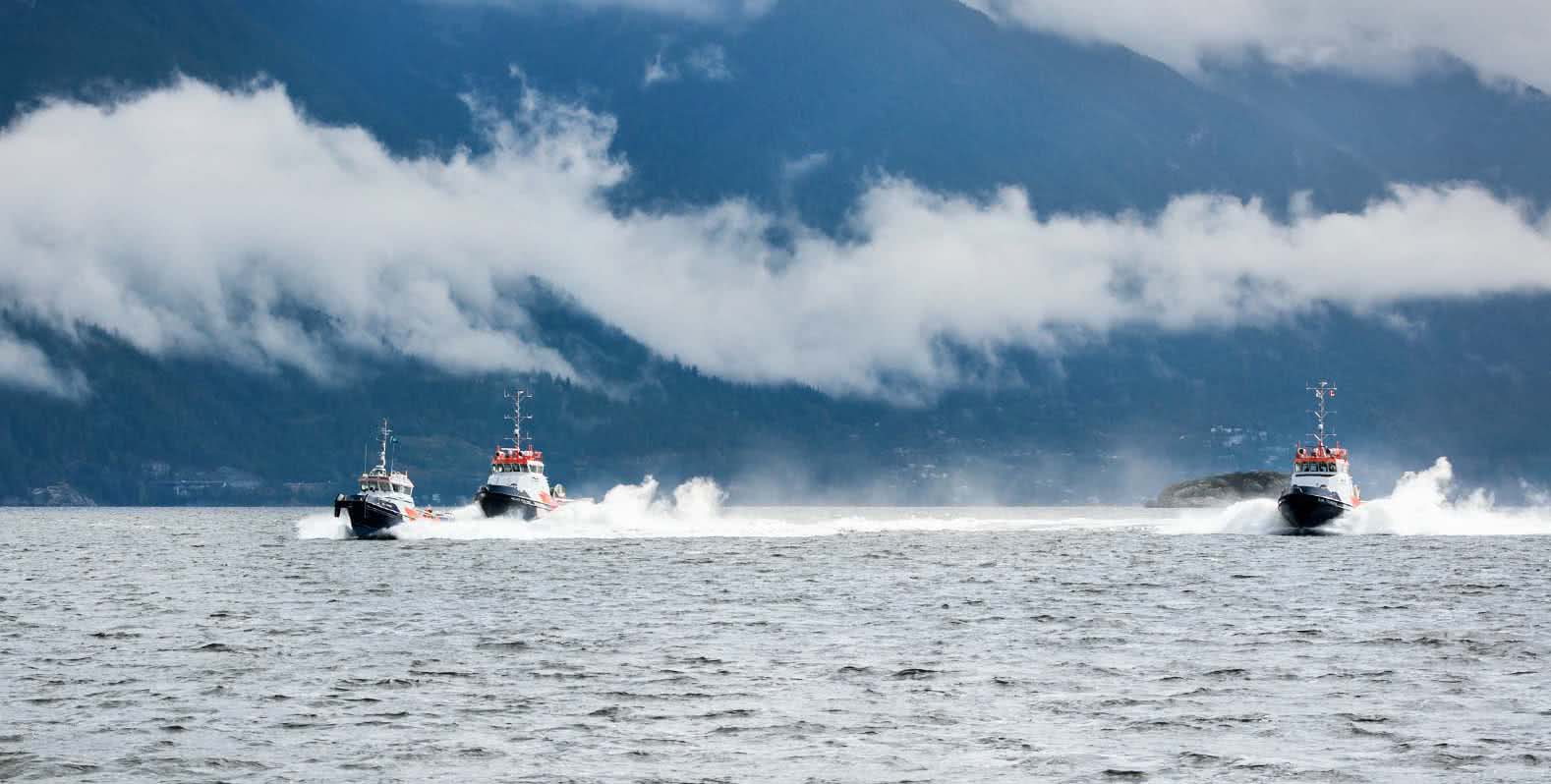
Our Story
Canada’s first marine spill response organization, established in 1976.
Who We Are
WCMRC is the only Transport Canada-certified marine response organization on Canada’s West Coast. On average, we respond to 20 spills each year.
Our mandate is to ensure there is a state of preparedness in place when a marine spill occurs and to mitigate the impacts on B.C.’s coast. This includes the protection of wildlife, economic and environmental sensitivities, and the safety of both responders and the public.
WCMRC is an industry-funded organization with more than 2,300 members. Membership is mandatory for vessels of a certain size calling on Canadian ports, as well as for oil-handling facilities receiving or shipping oil across their docks.
What We Do
At WCMRC we consistently work to improve and expand our operations to exceed global standards and deliver advanced marine spill response.
Our on-water operations form the core of our organization. WCMRC’s Operations team conducts continuous training and equipment maintenance to ensure ready-state response capability. In the event of a marine spill, our vessels and personnel are on-scene managing the recovery.
WCMRC’s Response Readiness Team (RRT) supports the Operations department’s ability to respond quickly and effectively to spills. The RRT creates and manages localized environmental protection strategies through ongoing field work, regularly reviews and updates our spill response plans, and manages key coastal partnerships through our Coastal Response Program.
WCMRC can also support in select response roles beyond on-water recovery and cleanup. This could include managing and staffing the Incident Command Post and training personnel in incident management.
History
1976
In 1976, an industry cooperative was established to clean up oil spills and other marine incidents in Vancouver Harbour. Originally named Burrard Clean Operations, the coop’s mandate was to maintain response preparedness and to respond to local marine spills from the coop’s members. Their geographic area of response was Burrard Inlet, which was defined as those waters and shorelines east of a line drawn between Point Grey and Point Atkinson.
1995
In 1995, following two large spills in Alaska and the state of Washington, the Canada Shipping Act was amended to include regulations and standards to protect all navigable waters in the country. It placed restrictions on tankers and barges of 150 tonnes and greater, on all ships 400 tonnes and greater, and on oil handling facilities that receive deliveries from these vessels. When these changes came into effect, WCMRC was formed to respond to spills in all of Western Canada’s navigable waters, and Burrard Clean became a division of WCMRC.
2023
In 2013, at the request of Trans Mountain, WCMRC undertook a capacity expansion. These Enhancements to WCMRC Oil Spill Response Preparedness Plans were conducted in Support of Trans Mountain Expansion Project. These enhancements supported Trans Mountain proposed voluntary enhancements to the existing 10,000 tonnes oil spill response planning standards that would improve WCMRC’s ability to efficiently respond to spills up to 20,000 tonnes in the IRA. The enhanced response regime, that will see $170 million invested in new equipment and new response bases for WCMRC, is available to all users of the local marine network. This expansion began in 2013 and was completed in 2024. It saw an increase in personnel from around 30 personnel in 2013 to 220 personnel in 2024 that includes 150 dedicated operations personnel and 70 corporate and base support personnel.
Our Mission, Vision, and Values
We respond to marine oil spills across Canada’s west coast.
Our Vision
Leading and innovating marine oil spill response.Our Values
We believe that putting our values into practice creates long-term benefits for our employees, members, stakeholders, suppliers and the communities we serve.- Safety: We foster a Just Culture where safety is a shared responsibility, encouraging openness and learning to promote a secure and resilient work environment.
- Accountability: We embrace a culture of ownership where every team member is committed to efficiency, readiness and continuous improvement.
- Integrity: We uphold unwavering ethical standards and transparency, ensuring our actions align with our words, building trust, and reinforcing our reputation for reliability.
- Environmental Responsibility: We are dedicated to protecting the environment through thoughtful decision-making, sustainable practices, and a commitment to mitigating potential risks.
- Teamwork: We value collaboration, where diverse perspectives and mutual respect enables us to adapt, innovate, and achieve excellence.
Accessibility Plan
Our 2024-2027 Accessibility Plan provides WCMRC with a guide to become the response organization Canada’s West Coast deserves. This plan is an important piece of our commitment to identifying, removing and preventing barriers, in alignment with fulfilling our mandate to ensure there is a state of preparedness in place when a marine spill occurs and to mitigate the impacts on B.C.’s coast.
This plan responds to our responsibilities under the Accessible Canada Act and is a part of the continuous improvement of our accessibility efforts. It shows where we are, what we learned, and where we plan to be three years from now.
You can download and review our Accessibility Plan in PDF.
Fight Against Forced Labour
WCMRC is committed to promoting labour practices that protect the human rights of workers in our operations and supply chains. This includes preventing and mitigating risks of forced labour and child labour. We strive to collaborate with our employees and suppliers to identify and eliminate, or otherwise control, risks to people impacted by our operations.
You can download and review our our report on our Fight Against Forced Labour in PDF.
Area of Operations
Our geographic area of response covers all 27,000 km of Western Canada’s coastline, extending to the 200 nautical mile limit. Our response area also includes all inland navigable waters in coastal British Columbia. We have bases, personnel and equipment caches stationed at strategic locations up and down the coast.
